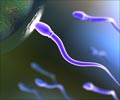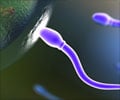Some sperm donors in US and Canada have anonymously fathered dozens of children, as there are no strict rules which prevent from doing so.

An international norm places the ceiling at 20 pregnancies from the same donor. In Denmark, the limit on a single donor is 25 births. And most sperm banks set their own regulations.
But the rules are not always respected. Some families try to create a "designer baby" by carefully choosing the donor from a catalog, drawn by his particular genes or characteristics, such as eye color or IQ level.
The practice has meant some of these star donors have now left a huge and at times overwhelming legacy, and the issue has stirred recent debate in Canada and the United States, spawning a number of films and documentaries.
"Starbuck," a popular Canadian comedy released this year, told the story of a perpetual bachelor who accidentally fathers 533 children by selling his semen for quick and easy cash.
In a stranger-than-fiction twist, Toronto documentary maker Barry Stevens has used his experiences -- born in Britain through a donor who then went on to sire some 500 to 1,000 children during his three decades working with sperm banks -- to fuel his own work.
His siblings are now spread across Canada, the United States, Europe and beyond.
And last month the US Style Network channel launched a reality series called "Sperm Donor" in which one donor, Ben Seisler, 33, tells of his surprise on going onto the registry and of learning that "to date I know of around 70 kids."
Specialists warn over-reliance of one donor increases the risk of the transmission of genetic diseases and malformations, and some say there are dangers of inadvertent incest between half-siblings.
"We can't exclude the possibility that children of one donor can meet and have sex, and children, and indeed the possibility that the donor himself could have sex with his daughter," said Stevens, who has made films about his search for his real father and his half-siblings.
Juliet Guichon, a professor of bioethics at the University of Calgary, said involuntary incest with donor children happens more frequently than it might at first seem.
"People who seek sperm donation are from the same socio-economical status. They know each other, they are advised to see the same doctor, they live in the same neighborhood. It's not randomly distributed," she said.
"Sperm giving is a market-driven phenomenon. What is governing this is market consideration, not consideration for the best interest of children. And that is why we have this outcome."
Guichon also noted that Canada lacks accurate data on the number of donor children in the country and suggested donor anonymity should be abolished to promote greater transparency and control.
Since 2004, donors have no longer been paid in Canada, leading to the depletion of stocks and forcing clinics to rely heavily on imports, especially from the United States.
The popularity of certain specific donors has also had a major impact. The US-based Donor Sibling Registry, which helps children get in touch with their half-brothers and sisters, highlighted the growing number of such families.
"We have a group of 150 children of one donor, and this number keeps growing," said Wendy Kramer, executive director and co-founder of the registry which she established in 2000 to connect so-called donor families.
"It's overwhelming for those kids, and we don't know how they will react."
Her group allows donor children to initiate contact anonymously at first. The donor is identified only by a number, but children can see how many half-siblings they likely might have.
Jonah Jacobson and his twin sister, Hilit, have in recent years formed a close bond with their half-siblings, Jayme and Jesse Clapoff, also twins whose biological father is the same donor, identified only by a number.
The four met through the sibling registry and now get together often and are in regular contact. And they have discovered that there are a total of 15 siblings from the same donor most of whom they have now met.
"We have the same sense of humor, we are all athletic. We all clicked together from the first time," Jonah told CNN last year.
And even though initially it can be a little awkward, "you definitely feel a bond right away," he added.
Source-AFP











